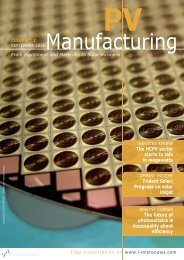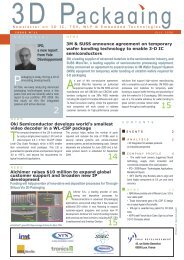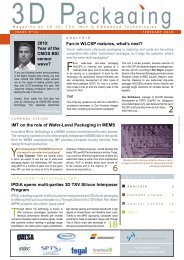the disruptive semiconductor technologies magazine - I-Micronews
the disruptive semiconductor technologies magazine - I-Micronews
the disruptive semiconductor technologies magazine - I-Micronews
Create successful ePaper yourself
Turn your PDF publications into a flip-book with our unique Google optimized e-Paper software.
OCTOBER 2010 issue n°100<br />
THE DISRUPTIVE SEMICONDUCTOR TECHNOLOGIES MAGAZINE<br />
MICROFLUIDICS<br />
New microfluidic device helps identify and capture breast cancer cells<br />
Researchers have developed a new disposable device that could help identify patients with advanced breast cancer<br />
awaiting drug <strong>the</strong>rapy with trastuzumab, and capture cancer cells that have an abnormal amount of <strong>the</strong> protein HER2.<br />
Benjamin Thierry, of <strong>the</strong> Ian Wark Research<br />
Institute at <strong>the</strong> University of South Australia,<br />
along with his colleagues, has created an<br />
elastic, disposable microfluidic device that can<br />
efficiently catch <strong>the</strong> protein HER2 – which is <strong>the</strong><br />
tyrosine kinase human epidermal growth factor<br />
receptor 2 – found in "aggressive breast cancers with<br />
poor prognosis."<br />
The only way to find out HER2 status in breast cancer<br />
patients now is through fluorescence in situ<br />
hybridization (FISH) or immunohistochemistry, both<br />
of which require biopsies. The problem with biopsybased<br />
testing is that it could lead to treatment that is<br />
ineffective, because <strong>the</strong> HER2 status of <strong>the</strong> primary<br />
tumor in 20 percent of breast cancers differs from <strong>the</strong><br />
HER2 status in that of a metastatic tumor. This<br />
information has led to <strong>the</strong> idea of isolating circulating<br />
tumor cells (CTCs), but this is difficult because<br />
circulating tumor cells exist at very low ratios of 1 to<br />
10 per billion blood cells.<br />
Establishing HER2 status is very critical because<br />
HER2 positive breast cancer patients have benefitted<br />
from drug <strong>the</strong>rapy with trastuzumab (Herceptin), which<br />
are humanized monoclonal antibodies against HER2.<br />
It also decreases recurrence risk by half. Also, <strong>the</strong> side<br />
effects and cost makes it a priority to identify patients<br />
who are HER2 positive. Now, Thierry and his colleagues'<br />
device has <strong>the</strong> ability to detect <strong>the</strong> status of HER2 and<br />
help capture circulating tumor cells. The device is made<br />
of organic silicon found in most contact lenses, and<br />
polydimethylsiloxane (PDMS), which are shampoos<br />
that are transparent, permeable to gasses, and<br />
compatible with soft molding techniques. The device<br />
also contains a polymeric layer on its surface, which has<br />
a large number of reactive molecules in it. Through <strong>the</strong><br />
use of a plasma-based polymerization process, this<br />
layer can attach to proteins that are able to catch cancer<br />
cells while leaving normal blood cells alone.<br />
Thierry's device showed an 80 percent immunocapture<br />
efficacy of HER2 positive cells, and is also<br />
cheaper and easier to make than previous<br />
microfabricated devices, which were developed to<br />
bind to cells of epi<strong>the</strong>lial tissues where <strong>the</strong> cancer<br />
originated, ultimately isolating CTCs.<br />
www.unisa.edu.au<br />
Lockheed Martin and ZyGEM accelerate DNA identification for law enforcement,<br />
homeland security and defense communities<br />
New, fast sample-to-answer DNA analysis platform previewed at 2010 Biometric Consortium conference.<br />
Lockheed Martin and ZyGEM Corp. Ltd. are<br />
unveiling a new DNA analysis system that has<br />
potential to transform how law enforcement,<br />
homeland security and defense communities use<br />
DNA-based identification in support of <strong>the</strong>ir missions.<br />
The prototype, called RapI.D., will be previewed at<br />
a 2010 Biometric Consortium Conference special<br />
session on Rapid DNA.<br />
Developed in collaboration with ZyGEM as a Lockheed<br />
Martin Technology Innovation Initiative, RapI.D.<br />
leverages <strong>the</strong> latest in microfluidic research and<br />
development to accelerate <strong>the</strong> DNA identification<br />
process – essentially building a laboratory on a small,<br />
single chip that reduces <strong>the</strong> processing steps and time<br />
needed for analysis. The RapI.D. platform is<br />
currently in prototype at ZyGEM's Charlottesville, Va.,<br />
MicroLab laboratories, with a Beta version expected<br />
to be released for testing in select laboratories early<br />
next year. The cost and complexity of current forensic<br />
DNA analysis methods has contributed to significant<br />
processing backlogs throughout <strong>the</strong> criminal justice<br />
system. Data from <strong>the</strong> Justice Department's FY 2009<br />
Forensic DNA Backlog Reduction Program suggest<br />
that <strong>the</strong> backlog has increased in recent years,<br />
indicating that <strong>the</strong> 2008 backlogged cases reported<br />
by state and local government applicants for funding<br />
under <strong>the</strong> program had nearly tripled compared to<br />
comparable data from 2005.<br />
www.lockheedmartin.com<br />
www.zygem.com<br />
Pacific Biosciences to raise up to $230 M in IPO<br />
Pacific Biosciences of California Inc said it<br />
expects to raise up to $230 million in an initial<br />
public offering of its common stock. The Menlo<br />
Park, California-based company expects to offer<br />
12.5 million shares at $15-$17 each, with an overallotment<br />
option of 1.9 million shares, it said in an<br />
amended filing.<br />
The life sciences company, which designs machines<br />
to speed up DNA sequencing in labs, sees net proceeds<br />
of $182.5 million, assuming <strong>the</strong> offering priced at $16<br />
per share, <strong>the</strong> mid-point of <strong>the</strong> range. The company<br />
plans to invest about $60-$70 million of <strong>the</strong> proceeds<br />
in its technology platform called single molecule, realtime,<br />
or SMRT technology. Pacific Biosciences initially<br />
filed for an IPO in August. The amended filing detailed<br />
<strong>the</strong> expected pricing of <strong>the</strong> common stock sale.<br />
JP Morgan, Morgan Stanley, Deutsche Bank and Piper<br />
Jaffray are underwriting <strong>the</strong> IPO, <strong>the</strong> company said.<br />
Pacific Biosciences plans to list its shares under <strong>the</strong><br />
ticker symbol "PACB" on Nasdaq.<br />
www.pacificbiosciences.com<br />
FluimediX closes financing round<br />
Funding Supports continued development of <strong>the</strong> NanoCycler platform to include a Warfarin Diagnostic Test.<br />
FluimediX announced that it has received<br />
funding for <strong>the</strong> continued development of <strong>the</strong><br />
NanoCycler, a diagnostic platform for <strong>the</strong><br />
measurement of relevant genetic mutations in<br />
patients. The proceeds of this financing round will be<br />
dedicated to developing a diagnostic test for Warfarin<br />
metabolism. The investment round was led by SEED<br />
Capital Denmark, a leading early stage investor<br />
managing more than € 200 million in total assets.<br />
Existing shareholders also participated in <strong>the</strong><br />
financing. The size of <strong>the</strong> round was not disclosed.<br />
Tomas Ussing, CEO and founder of FluimediX,<br />
commented: “Firstly, it is comprised of low cost, wellestablished<br />
components. Secondly, <strong>the</strong> use of<br />
plastic disposables enables extremely competitive<br />
molecular diagnostic testing, and will thus bring this<br />
type of testing closer to <strong>the</strong> patient. Thirdly, <strong>the</strong> built-in<br />
broad versatility of <strong>the</strong> NanoCycler device will allow<br />
o<strong>the</strong>r tests to be transferred to or developed for <strong>the</strong><br />
NanoCycler platform in <strong>the</strong> future.”<br />
The use of a diagnostic test for Warfarin metabolism<br />
would deliver important clinical benefits and cost<br />
savings to <strong>the</strong> healthcare system. Approximately two<br />
million people start taking Warfarin each year in <strong>the</strong><br />
U.S. Unfortunately, <strong>the</strong> optimal dose differs significantly<br />
due to patient-to-patient genetic variation in how<br />
quickly Warfarin is metabolized, and <strong>the</strong> medical<br />
consequences of under- or over-dosing <strong>the</strong> drug<br />
can be severe. Roughly one-third of <strong>the</strong> population<br />
carries a genetic mutation that results in slow<br />
metabolism of <strong>the</strong> drug, so <strong>the</strong> identification of those<br />
patients who have this mutation could help avoid <strong>the</strong><br />
consequences of under- or over-dosing.<br />
FX device lunch-box<br />
www.fluimedix.com<br />
FX chip<br />
Copyrights © Yole Développement SA. All rights reserved - Recycled paper<br />
11
















